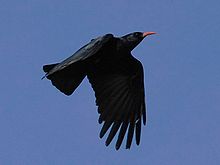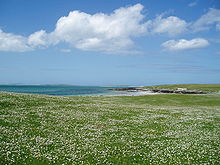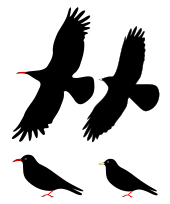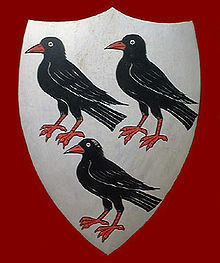- Red-billed Chough
-
Red-billed Chough 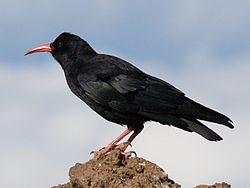
Adult of subspecies P. p. barbarus on La Palma, Canary Islands Conservation status Scientific classification Kingdom: Animalia Phylum: Chordata Class: Aves Order: Passeriformes Family: Corvidae Genus: Pyrrhocorax Species: P. pyrrhocorax Binomial name Pyrrhocorax pyrrhocorax
(Linnaeus, 1758)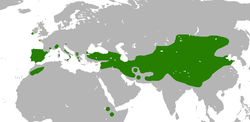
Approximate distribution shown in green The Red-billed Chough or Chough (
 /ˈtʃʌf/ chuff), Pyrrhocorax pyrrhocorax, is a bird in the crow family; it is one of only two species in the genus Pyrrhocorax. Its eight subspecies breed on mountains and coastal cliffs from Ireland and Great Britain east through southern Europe and North Africa to Central Asia, India and China.
/ˈtʃʌf/ chuff), Pyrrhocorax pyrrhocorax, is a bird in the crow family; it is one of only two species in the genus Pyrrhocorax. Its eight subspecies breed on mountains and coastal cliffs from Ireland and Great Britain east through southern Europe and North Africa to Central Asia, India and China.This bird has glossy black plumage, a long curved red bill, red legs, and a loud, ringing call. It has a buoyant acrobatic flight with widely spread primaries. The Red-billed Chough pairs for life and displays fidelity to its breeding site, which is usually a cave or crevice in a cliff face. It builds a wool-lined stick nest and lays three eggs. It feeds, often in flocks, on short grazed grassland, taking mainly invertebrate prey.
Although it is subject to predation and parasitism, the main threat to this species is changes in agricultural practices, which have led to population decline and range fragmentation in Europe; however, it is not threatened globally. The Red-billed Chough, which derived its common name from the Jackdaw, was formerly associated with fire-raising, and has links with Saint Thomas Becket and the county of Cornwall. The Red-billed Chough has been depicted on postage stamps of a few countries, including the Isle of Man, with four different stamps, and The Gambia where the bird does not occur.
Contents
Taxonomy
The Red-billed Chough was first described by Linnaeus in his Systema Naturae in 1758 as Upupa pyrrhocorax.[2] It was moved to its current genus, Pyrrhocorax, by Marmaduke Tunstall in his 1771 Ornithologia Britannica.[3] The genus name is derived from Greek πύρρος (purrhos), "flame-coloured", and κόραξ (korax), "raven".[4] The only other member of the genus is the Alpine Chough, Pyrrhocorax graculus.[5] The closest relatives of the choughs are the typical crows, Corvus, especially the jackdaws in the subgenus Coloeus.[6]
"Chough" was originally an alternative onomatopoeic name for the Jackdaw, Corvus monedula, based on its call. The similar red-billed species, formerly particularly common in Cornwall, became known initially as "Cornish Chough" and then just "Chough", the name transferring from one species to the other.[7] The Australian White-winged Chough, Corcorax melanorhamphos, despite its similar shape and habits, is only distantly related to the true choughs, and is an example of convergent evolution.[8]
Subspecies
There are eight extant subspecies, although differences between them are slight.[9]
- P. p. pyrrhocorax, the nominate subspecies and smallest form, is endemic to the British Isles, where it is restricted to Ireland, the Isle of Man, and the far west of Wales and Scotland,[9] although it has recently recolonised Cornwall after an absence of many years.[10]
- P. p. erythropthalmus, described by Louis Jean Pierre Vieillot in 1817 as Coracia erythrorhamphos,[11] occurs in the Red-billed Chough's continental European range, excluding Greece. It is larger and slightly greener than the nominate race.[9]
- P. p. barbarus, described by Charles Vaurie under its current name in 1954, is resident in North Africa and on La Palma in the Canary Islands. Compared to P. p. erythropthalmus, it is larger, has a longer tail and wings, and its plumage has a greener gloss. It is the longest-billed form, both absolutely and relatively.[12]
- P. p. baileyi described by Austin Loomer Rand and Charles Vaurie under its current name in 1955,[13] is a dull-plumaged subspecies endemic to Ethiopia, where it occurs in two separate areas. The two populations could possibly represent different subspecies.[9]
- P. p. docilis, described by Johann Friedrich Gmelin as Corvus docilis in 1774,[14] breeds from Greece to Afghanistan. It is larger than the African subspecies, but it has a smaller bill and its plumage is very green-tinted, with little gloss.[9]
- P. p. himalayanus, described by John Gould in 1862 as Fregilus himalayanus,[15] is found from the Himalayas to western China, but intergrades with P. p. docilis in the west of its range. It is the largest subspecies, long-tailed, and with blue or purple-blue glossed feathers.[9]
- P. p. centralis, described by Erwin Stresemann in 1928 under its current name,[16] breeds in central Asia. It is smaller and less strongly blue than P. p. himalayanus,[9] but its distinctness from the next subspecies has been questioned.[12]
- P. p. brachypus, described by Robert Swinhoe in 1871 as Fregilus graculus var. brachypus,[17] breeds in central and northern China, Mongolia and southern Siberia. It is similar to P. p. centralis but with a weaker bill.[9]
There is one known prehistoric form of the Red-billed Chough. P. p. primigenius, a subspecies that lived in Europe during the last ice age, which was described in 1875 by Alphonse Milne-Edwards from finds in southwest France.[18][19]
Detailed analysis of call similarity suggests that the Asiatic and Ethiopian races diverged from the western subspecies early in evolutionary history, and that Italian Red-billed Choughs are more closely allied to the North African subspecies than to those of the rest of Europe.[20]
Description
The adult of the nominate subspecies of the Red-billed Chough, P. p. pyrrhocorax, is 39–40 centimetres (15–16 in) in length, has a 73–90 centimetres (29–35 in) wingspan,[21] and weighs an average 310 grammes (10.9 oz).[4] Its plumage is velvet-black, green-glossed on the body, and it has a long curved red bill and red legs. The sexes are similar (although adults can be sexed in the hand using a formula involving tarsus length and bill width)[22] but the juvenile has an orange bill and pink legs until its first autumn, and less glossy plumage.[9]
The Red-billed Chough is unlikely to be confused with any other species. Although the Jackdaw and Alpine Chough share its range, the Jackdaw is smaller and has unglossed grey plumage, and the Alpine Chough has a short yellow bill. Even in flight, the two choughs can be distinguished by Alpine's less rectangular wings, and longer, less square-ended tail.[9]
The Red-billed Chough's loud, ringing chee-ow call is clearer and louder than the similar vocalisation of the Jackdaw, and always very different from that of its yellow-billed congener, which has rippling preep and whistled sweeeooo calls.[9] Small subspecies of the Red-billed Chough have higher frequency calls than larger races, as predicted by the inverse relationship between body size and frequency.[23]
Distribution and habitat
The Red-billed Chough breeds in Ireland, Great Britain, the Isle of Man, southern Europe and the Mediterranean basin, the Alps, and in mountainous country across Central Asia, India and China, with two separate populations in the Ethiopian Highlands. It is a non-migratory resident throughout its range.[9]
Its main habitat is high mountains; it is found between 2,000 and 2,500 metres (6,560–8,200 ft) in North Africa, and mainly between 2,400 and 3,000 metres (7,950–9,840 ft) in the Himalayas. In that mountain range it reaches 6,000 metres (19,650 ft) in the summer, and has been recorded at 7,950 metres (26,080 ft) altitude on Mount Everest.[9] In Ireland, Great Britain and Brittany it also breeds on coastal sea cliffs, feeding on adjacent short grazed grassland or machair. It was formerly more widespread on coasts but has suffered from the loss of its specialised habitat.[24][25] It tends to breed at a lower elevation than the Alpine Chough,[21] that species having a diet better adapted to high altitudes.[26]
Behaviour and ecology
Breeding
The Red-billed Chough breeds from three years of age, and normally raises only one brood a year,[4] although the age at first breeding is greater in large populations.[27] A pair exhibits strong mate and site fidelity once a bond is established.[28] The bulky nest is composed of roots and stems of heather, furze or other plants, and is lined with wool or hair;[21] in central Asia, the hair may be taken from live Himalayan Tahr.[29] The nest is constructed in a cave or similar fissure in a crag or cliff face.[21] In soft sandstone, the birds themselves excavate holes nearly a metre deep.[30] Old buildings may be used, and in Tibet working monasteries provide sites, as occasionally do modern buildings in Mongolian towns, including Ulan Bator.[9] The Red-billed Chough will utilise other artificial sites sites such as quarries and mineshafts for nesting where they are available.[31]
The Chough lays three to five eggs 3.9 x 2.8 centimetres (1.5 x 1.1 in) in size and weighing 15.7 grammes (0.55 oz), of which 6% is shell.[4] They are spotted, not always densely, in various shades of brown and grey on a creamy or slightly tinted ground.[21]
 Egg of Red-billed Chough
Egg of Red-billed Chough
The egg size is independent of the clutch size and the nest site, but may vary between different females.[32] The female incubates for 17–18 days before the altricial downy chicks are hatched, and is fed at the nest by the male. The female broods the newly hatched chicks for around ten days,[33] and then both parents share feeding and nest sanitation duties. The chicks fledge 31–41 days after hatching.[4]
Juveniles have a 43% chance of surviving their first year, and the annual survival rate of adults is about 80%. Choughs generally have a lifespan of about seven years,[4] although an age of 17 years has been recorded.[28] The temperature and rainfall in the months preceding breeding correlates with the number of young fledging each year and their survival rate. Chicks fledging under good conditions are more likely to survive to breeding age, and have longer breeding lives than those fledging under poor conditions.[27]
Feeding
The Red-billed Chough's food consists largely of insects, spiders and other invertebrates taken from the ground, with ants probably being the most significant item.[9] The Central Asian subspecies P. p. centralis will perch on the backs of wild or domesticated mammals to feed on parasites.[29] Although invertebrates make up most of the Chough's diet, it will eat vegetable matter including fallen grain, and in the Himalayas has been reported as damaging barley crops by breaking off the ripening heads to extract the corn.[9] In the Himalayas, they form large flocks in winter.[34]
The preferred feeding habitat is short grass produced by grazing, for example by sheep and rabbits, the numbers of which are linked to the Chough's breeding success. Suitable feeding areas can also arise where plant growth is hindered by exposure to coastal salt spray or poor soils.[35][36] It will use its long curved bill to pick ants, dung beetles and emerging flies off the surface, or to dig for grubs and other invertebrates. The typical excavation depth of 2–3 cm (0.8–1.2 in) reflects the thin soils which it feeds on, and the depths at which many invertebrates occur, but it may dig to 10–20 cm (4–8 in) in appropriate conditions.[37][38]
Where the two chough species occur together, there is only limited competition for food. An Italian study showed that the vegetable part of the winter diet for the Red-billed Chough was almost exclusively Gagea bulbs, whilst the Alpine Chough took berries and hips. In June, Red-billed Choughs fed on Lepidoptera larvae whereas Alpine Choughs ate cranefly pupae. Later in the summer, the Alpine Chough mainly consumed grasshoppers, whilst the Red-billed Chough added cranefly pupae, fly larvae and beetles to its diet.[26] Both choughs will hide food in cracks and fissures, concealing the cache with a few pebbles.[39]
Natural threats
The Red-billed Chough's predators include the Peregrine Falcon, Golden Eagle and Eurasian Eagle-owl, while the Common Raven will take nestlings.[40][41][42][43] In northern Spain, Red-billed Choughs preferentially nest near Lesser Kestrel colonies. This small insectivorous falcon is better at detecting a predator and more vigorous in defence than its corvid neighbours. The breeding success of the Red-billed Chough in the vicinity of the kestrels was found to be much higher than that of birds elsewhere, with a lower percentage of nest failures (16% near the falcon, 65% elsewhere).[43]
This species is occasionally parasitised by the Great Spotted Cuckoo, a brood parasite for which the Eurasian Magpie is the primary host.[44] Red-billed Choughs can acquire blood parasites such as Plasmodium, but a study in Spain showed that the prevalence was less than one percent, and unlikely to affect the life history and conservation of this species.[45] These low levels of parasitism contrast with a much higher prevalence in some other passerine groups; for example a study of thrushes in Russia showed that all the Fieldfares, Redwings and Song Thrushes sampled carried haematozoans, particularly Haemoproteus and Trypanosoma.[46]
Red-billed Choughs can also carry mites, but a study of the feather mite Gabucinia delibata, acquired by young birds a few months after fledging when they join communal roosts, suggested that this parasite actually improved the body condition of its host. It is possible that the feather mites enhance feather cleaning and deter pathogens,[47] and may complement other feather care measures such as sunbathing, and rubbing the plumage with ants (the formic acid from the insects deters parasites).[9]
Status
The Red-billed Chough has an extensive range, estimated at 10 million square kilometres (3.8 million sq mi), and a large population, including an estimated 86,000 to 210,000 individuals in Europe. Over its range as a whole, the species is not believed to approach the thresholds for the global population decline criterion of the IUCN Red List (i.e., declining more than 30% in ten years or three generations), and is therefore evaluated as Least Concern.[1]
However, the European range has declined and fragmented due to the loss of traditional pastoral farming, persecution and perhaps disturbance at breeding and nesting sites, although the numbers in France, Great Britain and Ireland may now have stabilised.[21] The European breeding population is between 12,265–17,370 pairs, but only in Spain is the species still widespread. Since in the rest of the continent breeding areas are fragmented and isolated, the Red-billed Chough has been categorised as "vulnerable" in Europe.[31]
In Spain, the Red-billed Chough has recently expanded its range by utilising old buildings, with 1,175 breeding pairs in a 9,716 square kilometre (3,692 sq mi) study area. These new breeding areas usually surround the original montane core areas. However, the populations with building nest sites are threatened by human disturbance, persecution and the loss of old buildings.[48] Fossils of both chough species were found in the mountains of the Canary Islands. The local extinction of the Alpine Chough and the reduced range of Red-billed chough in the islands may have been due to climate change or human activity.[49]
In culture
In Greek mythology, the Red-billed Chough, also known as 'sea-crow', was considered sacred to the Titan Cronus and dwelt on Calypso's 'Blessed Island',[50] where "The birds of broadest wing their mansions form/The chough, the sea-mew, the loquacious crow,"[51]
The Red-billed Chough has a long association with Cornwall, and appears on the Cornish Coat of Arms.[52] According to Cornish legend King Arthur did not die after his last battle but rather his soul migrated into the body of a Red-billed Chough, the red colour of its bill and legs being derived from the blood of the last battle [53] and hence killing this bird was unlucky.[50] Legend also holds that after the last Cornish Chough departs from Cornwall, then the return of the Chough, as happened in 2001, will mark the return of King Arthur.[54]
Up to the eighteenth century, the Red-billed Chough was associated with fire-raising, and was described by William Camden as incendaria avis, "oftentime it secretly conveieth fire sticks, setting their houses afire".[7] Daniel Defoe was also familiar with this story:
It is counted little better than a kite, for it is of ravenous quality, and is very mischievous; it will steal and carry away any thing it finds about the house, that is not too heavy, tho' not fit for its food; as knives, forks, spoons and linnen cloths, or whatever it can fly away with, sometimes they say it has stolen bits of firebrands, or lighted candles, and lodged them in the stacks of corn, and the thatch of barns and houses, and set them on fire; but this I only had by oral tradition.[55]
Not all mentions of "chough" refer to this species. Because of the origins of its name, when Shakespeare writes of "the crows and choughs that wing the midway air" [King Lear, act 4, scene 6] or Henry VIII's Vermin Act of 1532 is "ordeyned to dystroye Choughes, Crowes and Rookes", they are clearly referring to the Jackdaw.[7]
In heraldry, choughs are known as "beckits". Three Red-billed Choughs are depicted on the coat of arms of Thomas Becket, Archbishop of Canterbury,[56] and the city of Canterbury also has choughs on its coat of arms, because of its connection to the saint.[57] This species has been depicted on the stamps of Bhutan, The Gambia, the Isle of Man, Turkmenistan and Yugoslavia.[58]
References
- ^ a b BirdLife International (2009). "Pyrrhocorax pyrrhocorax". IUCN Red List of Threatened Species. Version 2008. International Union for Conservation of Nature. http://www.iucnredlist.org/apps/redlist/details/146638. Retrieved 4 November 2009.
- ^ (Latin) Linnaeus, C (1758). Systema naturae per regna tria naturae, secundum classes, ordines, genera, species, cum characteribus, differentiis, synonymis, locis. Tomus I. Editio decima, reformata.. Holmiae. (Laurentii Salvii).. pp. 118. "U. atra, rostro pedibusque rubris"
- ^ (Latin) Tunstall, Marmaduke (1771). Ornithologia Britannica: seu Avium omnium Britannicarum tam terrrestrium, quam aquaticarum catalogus, sermone Latino, Anglico et Gallico redditus. London, J. Dixwell. pp. 2.
- ^ a b c d e f "Chough Pyrrhocorax pyrrhocorax [Linnaeus, 1758"]. BTOWeb BirdFacts. British Trust for Ornithology. http://blx1.bto.org/birdfacts/results/bob15590.htm. Retrieved 2008-02-06.
- ^ "ITIS Standard Report Page: Pyrrhocorax". Integrated Taxonomic Information System. http://www.itis.gov/servlet/SingleRpt/SingleRpt?search_topic=TSN&search_value=558155. Retrieved 2008-02-05.
- ^ Goodwin, Derek; Gillmor, Robert (1976). Crows of the World. London: British Museum (Natural History). pp. 151. ISBN 0565007718.
- ^ a b c Cocker, Mark; Mabey, Richard (2005). Birds Britannica. London: Chatto & Windus. ISBN 0-7011-6907-9. 406–8
- ^ "ITIS Standard Report Page: Corcorax". Integrated Taxonomic Information System. http://www.itis.gov/servlet/SingleRpt/SingleRpt?search_topic=TSN&search_value=557570. Retrieved 2008-02-05.
- ^ a b c d e f g h i j k l m n o p q Madge, Steve; Burn, Hilary (1994). Crows and jays: a guide to the crows, jays and magpies of the world. A&C Black. pp. 133–5. ISBN 0-7136-3999-7.
- ^ "The Cornish Chough". Cornwall County Council. http://www.cornwall.gov.uk/index.cfm?articleid=4445. Retrieved 2008-02-05.
- ^ (French) Vieillot, Louis Jean Pierre (1817). Nouveau dictionnaire d'histoire naturelle. volume 8, 12.
- ^ a b Vaurie, Charles (May 1954). "Systematic Notes on Palearctic Birds. No. 4 The Choughs (Pyrrhocorax)". American Museum Novitates (1658). http://hdl.handle.net/2246/3595.
- ^ Rand, Austin Loomer; Vaurie, Charles (1955). "A new chough from the highlands of Abyssinia". Bulletin of the British Ornithologists' Club 75: 28.
- ^ (German) Gmelin, Johann Friedrich (1774). Reise durch Russland. volume 3, 365.
- ^ Gould, John (1862). "[Two new species of hummingbird, a new Fregilus from the Himalayas and a new species of Prion]". Proceedings of the Zoological Society of London: 125.
- ^ (German) Stresemann, Erwin (1928). "Die Vögel der Elburs Expedition 1927". Journal of Ornithology 76 (2): 313–326. doi:10.1007/BF01940684.
- ^ Swinhoe, Robert (1871). "A revised catalogue of the birds of China and its islands, with descriptions of new species, references to former notes, and occasional remarks". Proceedings of the Zoological Society of London: 383.
- ^ Milne-Edwards, Alphonse; Lartet, Édouard & Christy, Henry (eds.) (1875). Reliquiae aquitanicae: being contributions to the archaeology and palaeontology of Pèrigord and the adjoining provinces of Southern France. London : Williams. pp. 226–247.
- ^ (French) Mourer-Chauviré, Cécile (1975). "Les oiseaux du Pléistocène moyen et supérieur de France". Documents des Laboratoires de Géologie de la Faculté des Sciences de Lyon n° 64.
- ^ Laiolo, Paola; Rolando, Antonio; Delestrade, Anne & De Sanctis, Augusto (2004). "Vocalizations and morphology: interpreting the divergence among populations of Red-billed Chough Pyrrhocorax pyrrhocorax and Alpine Chough P. graculus". Bird Study 51 (3): 248–255. doi:10.1080/00063650409461360. http://www.ingentaconnect.com/content/bto/bird/2004/00000051/00000003/art00008.
- ^ a b c d e f Snow, David; Perrins, Christopher M (editors) (1998). The Birds of the Western Palearctic concise edition (2 volumes). Oxford: Oxford University Press. ISBN 0-19-854099-X. 1466–68
- ^ Blanco, Guillermo; Tella, José Luis; Torre, Ignacio (Summer 1996). "Age and sex determination of monomorphic non-breeding choughs: a long-term study" (PDF). Journal of Field Ornithology 67 (3): 428–433. http://elibrary.unm.edu/sora/JFO/v067n03/p0428-p0433.pdf.
- ^ Laiolo, Paola; Rolando, Antonio; Delestrade, Anne; de Sanctis, Augusto (May 2001). "Geographical Variation in the Calls of the Choughs". The Condor 103 (2): 287–297. doi:10.1650/0010-5422(2001)103[0287:GVITCO]2.0.CO;2. ISSN 0010-5422.
- ^ "Chough". Royal Society for the Protection of Birds. http://www.rspb.org.uk/ourwork/conservation/species/casestudies/chough.asp. Retrieved 2008-02-05.
- ^ "Cornwall Chough Project". Conservation. Royal Society for the Protection of Birds. Archived from the original on October 8, 2007. http://web.archive.org/web/20071008043129/http://www.rspb.org.uk/ourwork/conservation/projects/cornwallchoughs/index.asp. Retrieved 2008-03-22.
- ^ a b Rolando, A; Laiolo, P (April 1997). "A comparative analysis of the diets of the chough Pyrrhocorax pyrrhocorax and the alpine chough Pyrrhocorax graculus coexisting in the Alps". Ibis 139 (2): 388–395. doi:10.1111/j.1474-919X.1997.tb04639.x.
- ^ a b Reid, J. M.; Bignal, E. M.; Bignal, S.; McCracken, D. I.; Monaghan, P. (2003). "Environmental variability, life-history covariation and cohort effects in the red-billed chough Pyrrhocorax pyrrhocorax". Journal of Animal Ecology 72 (1): 36–46. doi:10.1046/j.1365-2656.2003.00673.x.
- ^ a b Roberts, P. J. (1985). "The choughs of Bardsey". British Birds 78 (5): 217–32.
- ^ a b Baietto, Marco; Masin, Simone; Vaghi, Serena; Padoa-Schioppa, Emilio (2007). "Observation of Red-Billed Chough (Pyrrhocorax pyrrhocorax) Removing Fur from Himalayan Tahr (Hemitragus jemlahicus)" (PDF). Research Journal of Biological Sciences 2 (1): 89–90. http://www.medwelljournals.com/fulltext/rjbs/2007/89-90.pdf.
- ^ Ali, Salim; Ripley, S Dillon (1986). Handbook of the birds of India and Pakistan. 5 (2 ed.). Oxford University Press. pp. 239–242. ISBN 0195620631.
- ^ a b "Chough Pyrrhocorax pyrrhocorax (breeding)" (PDF). Joint Nature Conservation Committee. http://www.jncc.gov.uk/pdf/UKSPA/UKSPA-A6-102A.pdf. Retrieved 2008-02-06.
- ^ Stillman, Richard A.; Bignal, Eric M.; McCracken, David I.; Ovenden, Gy N. (1998). "Clutch and egg size in the Chough Pyrrhocorax pyrrhocorax on Islay, Scotland" (PDF). Bird Study 45: 122–126. doi:10.1080/00063659809461085. http://docstore.ingenta.com/cgi-bin/ds_deliver/1/u/d/ISIS/43251289.1/bto/bird/1998/00000045/00000001/451122/1C2A1CE95547C5F41206795794E5625722807C89F5.pdf?link=http://www.ingentaconnect.com/error/delivery&format=pdf.
- ^ Laiolo, P.; Bignal, E.M.; Patterson, I.J. (1998). "The dynamics of parental care in Choughs(Pyrrhocorax pyrrhocorax)". Journal of Ornithology 139 (3): 297–305. doi:10.1007/BF01653340.
- ^ Rasmussen, Pamela C.; Anderson, John C. (2005). Birds of South Asia. The Ripley Guide. Volume 2. Smithsonian Institution and Lynx Edicions. pp. 597–598.
- ^ Mccanch, Norman (November 2000). "The relationship between Red-Billed Chough Pyrrhocorax pyrrhocorax (L) breeding populations and grazing pressure on the Calf of Man". Bird Study 47 (3): 295–303. doi:10.1080/00063650009461189.
- ^ Blanco, Guillermo; Tella, José Luis; Torre, Ignacio (July 1998). "Traditional farming and key foraging habitats for chough Pyrrhocorax pyrrhocorax conservation in a Spanish pseudosteppe landscape". Journal of Applied Ecology 35 (23): 232–239. doi:10.1046/j.1365-2664.1998.00296.x.
- ^ Roberts, P. J. (1983). "Feeding habitats of the Chough on Bardsey Island (Gwynedd)" (PDF). Bird Study 30 (1): 67– 72. doi:10.1080/00063658309476777. http://pdfserve.informaworld.com/948318__912643392.pdf.
- ^ Morris, Rev. Francis Orpen (1862). A history of British birds, volume 2. London, Groombridge and Sons. p. 29.
- ^ Wall, Stephen B. Vander (1990). Food hoarding in animals. University of Chicago Press. pp. 306. ISBN 0226847357.
- ^ "A year in the life of Choughs". Birdwatch Ireland. http://www.birdwatchireland.ie/Default.aspx?tabid=206. Retrieved 2008-02-06.
- ^ "Release Update Dec 2003" (PDF). Operation Chough. http://www.paradisepark.org.uk/choughs/2003/updatedec03.pdf. Retrieved 2008-02-06.
- ^ Rolando, Antonio; Caldoni, Riccardo; De Sanctis, Augusto; Laiolo, Paola (2001). "Vigilance and neighbour distance in foraging flocks of red-billed choughs, Pyrrhocorax pyrrhocorax". Journal of Zoology 253 (2): 225–232. doi:10.1017/S095283690100019X.
- ^ a b Blanco, Guillermo; Tella, José Luis (August 1997). "Protective association and breeding advantages of choughs nesting in lesser kestrel colonies". Animal Behaviour 54 (2): 335–342. doi:10.1006/anbe.1996.0465. PMID 9268465.
- ^ Soler, Manuel; Palomino, Jose Javier; Martinez, Juan Gabriel; Soler, Juan Jose (1995). "Communal parental care by monogamous magpie hosts of fledgling Great Spotted Cuckoos" (PDF). The Condor (The Condor, Vol. 97, No. 3) 97 (3): 804–810. doi:10.2307/1369188. JSTOR 1369188. http://www.eeza.csic.es/eeza/documentos/soler_communal%20parental%20care.pdf.
- ^ Blanco, Guillermo; Merino, Santiago; Tella, Joseé Luis; Fargallo, Juan A; Gajon, A (1997). "Hematozoa in two populations of the threatened red-billed chough in Spain" (PDF). Journal of Wildlife Diseases 33 (33): 642–5. http://www.jwildlifedis.org/cgi/reprint/33/3/642.pdf.
- ^ Palinauskas, Vaidas; Markovets, Mikhail Yu; Kosarev, Vladislav V; Efremov, Vladislav D; Sokolov Leonid V; Valkiûnas, Gediminas (2005). "Occurrence of avian haematozoa in Ekaterinburg and Irkutsk districts of Russia". Ekologija 4: 8–12.
- ^ Blanco, Guillermo; Tella, Jose Luis; Potti, Jaime (September 1997). "Feather Mites on Group-Living Red-Billed Choughs: A Non-Parasitic Interaction?". Journal of Avian Biology (Journal of Avian Biology, Vol. 28, No. 3) 28 (3): 197–206. doi:10.2307/3676970. JSTOR 3676970.
- ^ Blanco, Guillermo; Fargallo, Juan A.; Tella, José Luis; Cuevas; Jesús A. (February–March 1997). "Role of buildings as nest-sites in the range expansion and conservation of choughs Pyrrhocorax pyrrhocorax in Spain". Biological Conservation 79 (2–3): 117–122. doi:10.1016/S0006-3207(96)00118-8.
- ^ Reyes, Juan Carlos Rando (2007). "New fossil records of choughs genus Pyrhocorax in the Canary Islands: hypotheses to explain its extinction and current narrow distribution". : Ardeola 54 (2): 185–195.
- ^ a b de Vries, Ad (1976). Dictionary of Symbols and Imagery. Amsterdam: North-Holland Publishing Company. pp. 97. ISBN 0-7204-8021-3.
- ^ "Book V. The departure of Ulysses from Calypso". The Odyssey of Homer, translated by Alexander Pope. http://ebooks.adelaide.edu.au/h/homer/h8op/book5.html. Retrieved 2008-03-22.
- ^ "The Cornwall County Council Coat of Arms". Cornwall County Council. http://www.cornwall.gov.uk/index.cfm?articleid=13148. Retrieved 2008-02-06.
- ^ Newlyn, Lucy; Wilkinson, Lucy (illustrator) (2005). Chatter of Choughs: An Anthology Celebrating the Return of Cornwall’s Legendary Bird. Hypatia Publications. pp. 31. ISBN 1872229492.
- ^ Carrell, Severin (27 January 2002). "Cornish chuffed at the return of the chough". The Independent. http://www.independent.co.uk/environment/cornish-chuffed-at-the-return-of-the-chough-671071.html. Retrieved 27 November 2010.
- ^ Defoe, Daniel (1724-7). A tour thro' the whole island of Great Britain, divided into circuits or journies (Appendix To Letter III).
- ^ "Keeping the Twelve Days of Christmas". Fullhomelydivinity.org. http://fullhomelydivinity.org/articles/Twelve%20Days%20of%20Christmas.htm. Retrieved 2008-02-06.
- ^ "The City Arms of Canterbury". Canterbury City Council. http://www.canterbury.gov.uk/buildpage.php?id=217. Retrieved 2008-02-06.[dead link]
- ^ Scharning, Kjell. "Red-billed Chough Pyrrhocorax pyrrhocorax". Theme Birds on Stamps. http://www.birdtheme.org/species/imagespage.php?spec=1689&fl=P. Retrieved 4 June 2009.
External links
- RSPB information, sounds and videos
- ARKIVE images
- Operation Chough, the return to Cornwall
- John Harris poem The Cornish Chough
- Ageing and sexing (PDF) by Javier Blasco-Zumeta
- Red-billed Choughs on postage stamps
Extant species of family Corvidae Kingdom: Animalia · Phylum: Chordata · Class: Aves · Subclass: Neornithes · Superorder: Neognathae · Order: PasseriformesFamily Corvidae Choughs Treepies PlatysmurusTemnurusOriental
magpiesOld World jays PtilostomusStresemann's
BushcrowZavattariornis
Culture of Cornwall Symbols Celtic cross · Cornish chough · Cornish heath · Cornish kilts and tartans · Jonathan Trelawny · Michael An Gof · Saint Piran · Saint Piran's Flag

Festivals Sports Cuisine Arts Music Cornish bagpipes · Brenda Wootton · Gwenno Saunders · Fisherman's Friends
Folk songsLanguage Folklore Beast of Bodmin · Blunderbore · Bucca · Cruel Coppinger · Knocker · King Arthur · Lyonesse · Owlman · Piskie
Organisations Categories:- IUCN Red List least concern species
- Birds of Asia
- Birds of Pakistan
- Birds of Europe
- Heraldic birds
- British Isles coastal fauna
- Cornish culture
- Environment of Cornwall
Wikimedia Foundation. 2010.
Look at other dictionaries:
red-billed chough — raudonsnapė alpinė kuosa statusas T sritis zoologija | vardynas atitikmenys: lot. Pyrrhocorax pyrrhocorax angl. red billed chough vok. Alpenkrähe, f rus. клушица, f; красноклювая альпийская галка, f pranc. crave à bec rouge, m ryšiai: platesnis… … Paukščių pavadinimų žodynas
Chough — In the Bernese Alps, Switzerland Scientific classification Kingdom: A … Wikipedia
chough — /tʃʌf / (say chuf) noun 1. either of two glossy black corvine birds, the red billed chough, Pyrrhocorax pyrrhocorax, and the yellow billed chough, or Alpine chough, P. graculus, of Eurasia and north western Africa. 2. white winged chough, a sooty …
chough — /chuf/, n. any of several crowlike Old World birds, esp. Pyrrhocorax pyrrhocorax, of Europe. [1275 1325; ME choghe; akin to OE ceo, D kauw, Dan kaa] * * * ▪ bird any of three crowlike birds with down curved bills. In the family Corvidae (q.v.;… … Universalium
Alpine Chough — Taxobox name = Alpine Chough status = LC status system = iucn3.1 image width = 250px regnum = Animalia phylum = Chordata classis = Aves ordo = Passeriformes familia = Corvidae genus = Pyrrhocorax species = P. graculus binomial = Pyrrhocorax… … Wikipedia
Thick-billed Raven — Conservation status Least Concern ( … Wikipedia
White-billed Crow — Conservation status Least Concern ( … Wikipedia
Long-billed Crow — Conservation status Least Concern (IUCN 3.1)[1] … Wikipedia
Slender-billed Crow — Conservation status Least Concern (IUCN 3.1 … Wikipedia
cornish chough — noun Usage: usually capitalized 1st C Etymology: cornish (I) 1. : a red billed chough (Pyrrhocorax pyrrhocorax) now rare in England but found in mountainous parts of Europe and northern Africa 2. : the heraldic representation of a Cornish chough… … Useful english dictionary



